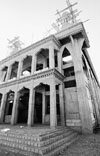| |
Over the past 10 centuries or more, except for some monasteries
and residences of rich people in Lhasa, Xigaze and other areas,
no progress has been made in Tibet in developing a modern building
industry. Before the Democratic Reform in 1959, the urban area of
Lhasa was less than 3 square km, with a population of only around
30,000. And the construction area of residential buildings was only
220,000 square meters.
 After
the peaceful liberation in 1951, Tibet still failed to launch urban
construction on a large scale due to the difficulties left over
by history, including an underdeveloped economy, backward communication
and transportation facilities and shortage of materials and technologies.
In the eight years from the peaceful liberation in 1951 to the Democratic
Reform in 1959, only some badly needed public facilities for electric
supply, medicine, culture, education and sanitation were built. After
the peaceful liberation in 1951, Tibet still failed to launch urban
construction on a large scale due to the difficulties left over
by history, including an underdeveloped economy, backward communication
and transportation facilities and shortage of materials and technologies.
In the eight years from the peaceful liberation in 1951 to the Democratic
Reform in 1959, only some badly needed public facilities for electric
supply, medicine, culture, education and sanitation were built.
Since 1959, however, the Central Government has sent a large group
of workers, cadres, intellectuals and engineers selected from the
whole country to Tibet to help improve the poor and backward local
situations. As a result, a great improvement was seen in urban construction
in the cities of Lhasa and Xigaze, which elevated the region's building
industry to a new stage. In Tibet, which is dubbed "the roof of
the world"for its high location above sea level, a group of modern
buildings with strong ethnic and local flavors have sprung up.
After the mid-1980s, along with the deepening of reform and opening-up,
many building workers flowed into Tibet from the inland areas, injecting
new vigor to the local building sector. In Lhasa, Xigaze and some
other important area, many buildings are of composite structure
normally found in inland areas, while others are of wood-and-stone
structures geared for the renovation of old buildings. The adroit
design combining modern art with local tradition reflects a strong
national flavor. The building sector has made great contributions
to protecting the old Tibetan culture and art, and to keeping abreast
of the world's advanced trends in the building sector.
 During
the Ninth Five-Year Plan (1996-2000), 15 provinces and cities, each
having a specific target location in Tibet for aid, launched urban
construction projects suited to Tibetan conditions. This has greatly
pushed up the construction in cities and towns, with the urban facilities
further improving in these places. During
the Ninth Five-Year Plan (1996-2000), 15 provinces and cities, each
having a specific target location in Tibet for aid, launched urban
construction projects suited to Tibetan conditions. This has greatly
pushed up the construction in cities and towns, with the urban facilities
further improving in these places.
By the end of 2000, the daily supply capacity of running water to
cities and towns reached 320,000 cubic meters. Running water was
supplied to 60 percent of urban residents. Gas and solar energy
stoves are widely used, with 230,000 people using liquefied gas.
Hence, a great improvement has been witnessed in the appearance
of the city. In addition, some buildings with local marks and Tibetan
features have sprung up, enriching city sightseeing places.
|
|

